Importance of Hofstede's Cultural Dimensions in International Business
VerifiedAdded on 2021/01/02
|7
|1523
|116
Essay
AI Summary
This essay delves into the significance of Hofstede's cultural dimensions in international business, exploring how cultural norms and behaviors influence organizational practices and strategies. The essay begins with an introduction to culture and Hofstede's model, emphasizing its role in cross-cultural communication and understanding societal values. The main body examines the importance of these dimensions for businesses operating internationally, highlighting how companies must adapt policies and codes of conduct to align with different cultural contexts. It provides suggestions for incorporating cultural dimensions into organizational strategies, such as fostering familiar and comfortable work environments, adopting local languages, and promoting innovation. The essay critically evaluates these suggestions, acknowledging both positive and negative implications, and discusses the author's agreement or disagreement with specific points. It concludes by summarizing the key takeaways and emphasizing the essential role of cultural understanding in achieving organizational success and growth in the global market.

Individual essay
Paraphrase This Document
Need a fresh take? Get an instant paraphrase of this document with our AI Paraphraser
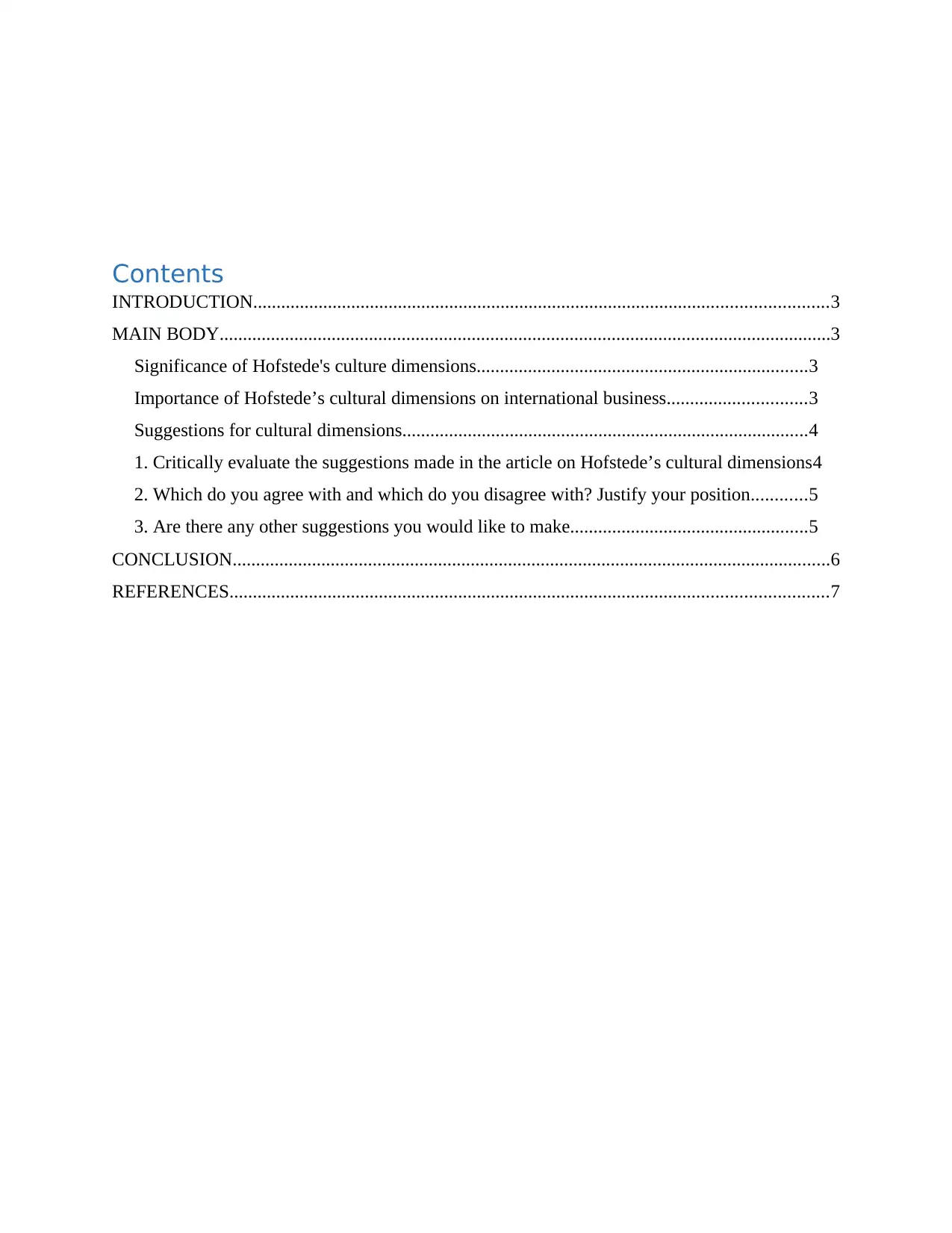
Contents
INTRODUCTION...........................................................................................................................3
MAIN BODY...................................................................................................................................3
Significance of Hofstede's culture dimensions.......................................................................3
Importance of Hofstede’s cultural dimensions on international business..............................3
Suggestions for cultural dimensions.......................................................................................4
1. Critically evaluate the suggestions made in the article on Hofstede’s cultural dimensions4
2. Which do you agree with and which do you disagree with? Justify your position............5
3. Are there any other suggestions you would like to make...................................................5
CONCLUSION................................................................................................................................6
REFERENCES................................................................................................................................7
INTRODUCTION...........................................................................................................................3
MAIN BODY...................................................................................................................................3
Significance of Hofstede's culture dimensions.......................................................................3
Importance of Hofstede’s cultural dimensions on international business..............................3
Suggestions for cultural dimensions.......................................................................................4
1. Critically evaluate the suggestions made in the article on Hofstede’s cultural dimensions4
2. Which do you agree with and which do you disagree with? Justify your position............5
3. Are there any other suggestions you would like to make...................................................5
CONCLUSION................................................................................................................................6
REFERENCES................................................................................................................................7
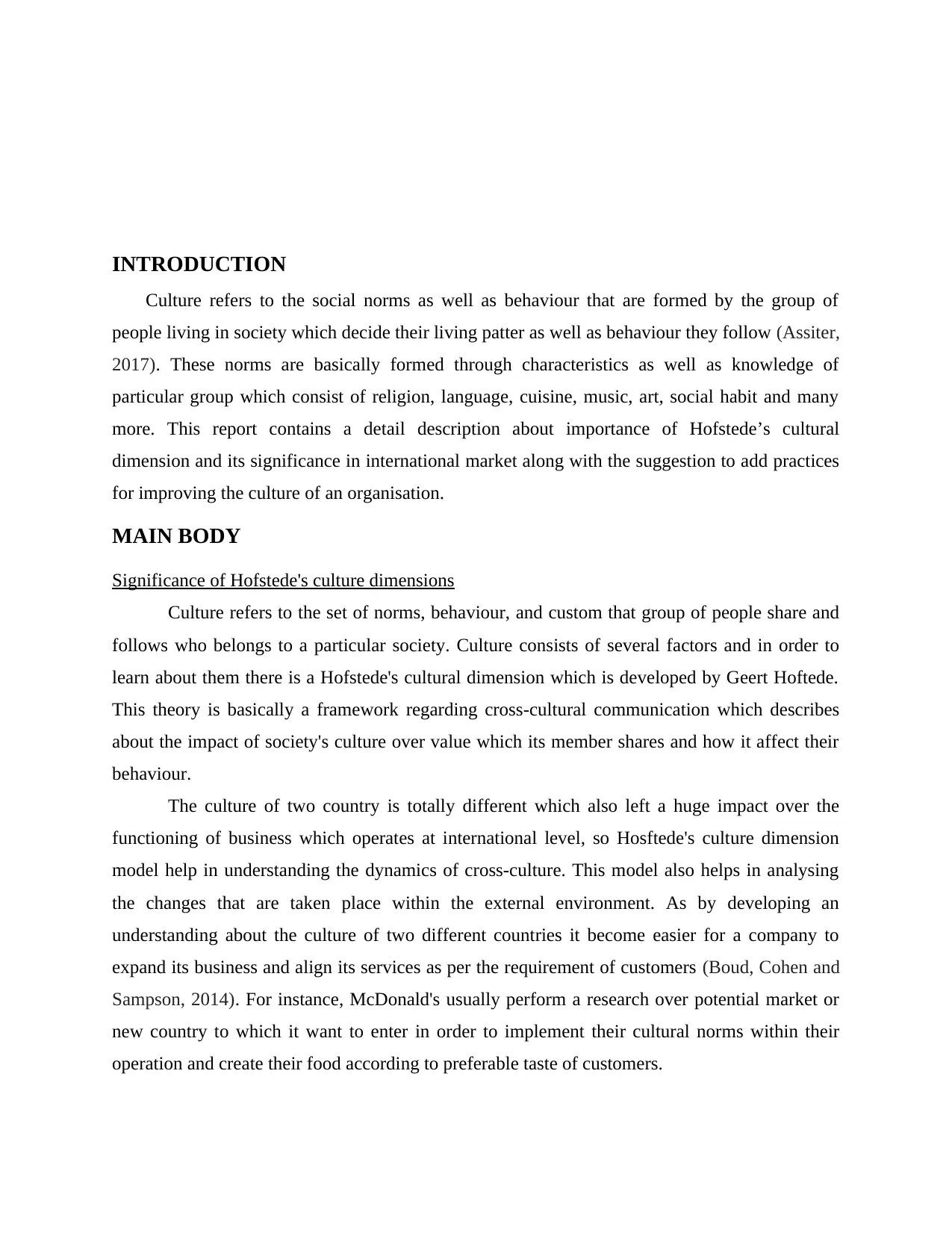
INTRODUCTION
Culture refers to the social norms as well as behaviour that are formed by the group of
people living in society which decide their living patter as well as behaviour they follow (Assiter,
2017). These norms are basically formed through characteristics as well as knowledge of
particular group which consist of religion, language, cuisine, music, art, social habit and many
more. This report contains a detail description about importance of Hofstede’s cultural
dimension and its significance in international market along with the suggestion to add practices
for improving the culture of an organisation.
MAIN BODY
Significance of Hofstede's culture dimensions
Culture refers to the set of norms, behaviour, and custom that group of people share and
follows who belongs to a particular society. Culture consists of several factors and in order to
learn about them there is a Hofstede's cultural dimension which is developed by Geert Hoftede.
This theory is basically a framework regarding cross-cultural communication which describes
about the impact of society's culture over value which its member shares and how it affect their
behaviour.
The culture of two country is totally different which also left a huge impact over the
functioning of business which operates at international level, so Hosftede's culture dimension
model help in understanding the dynamics of cross-culture. This model also helps in analysing
the changes that are taken place within the external environment. As by developing an
understanding about the culture of two different countries it become easier for a company to
expand its business and align its services as per the requirement of customers (Boud, Cohen and
Sampson, 2014). For instance, McDonald's usually perform a research over potential market or
new country to which it want to enter in order to implement their cultural norms within their
operation and create their food according to preferable taste of customers.
Culture refers to the social norms as well as behaviour that are formed by the group of
people living in society which decide their living patter as well as behaviour they follow (Assiter,
2017). These norms are basically formed through characteristics as well as knowledge of
particular group which consist of religion, language, cuisine, music, art, social habit and many
more. This report contains a detail description about importance of Hofstede’s cultural
dimension and its significance in international market along with the suggestion to add practices
for improving the culture of an organisation.
MAIN BODY
Significance of Hofstede's culture dimensions
Culture refers to the set of norms, behaviour, and custom that group of people share and
follows who belongs to a particular society. Culture consists of several factors and in order to
learn about them there is a Hofstede's cultural dimension which is developed by Geert Hoftede.
This theory is basically a framework regarding cross-cultural communication which describes
about the impact of society's culture over value which its member shares and how it affect their
behaviour.
The culture of two country is totally different which also left a huge impact over the
functioning of business which operates at international level, so Hosftede's culture dimension
model help in understanding the dynamics of cross-culture. This model also helps in analysing
the changes that are taken place within the external environment. As by developing an
understanding about the culture of two different countries it become easier for a company to
expand its business and align its services as per the requirement of customers (Boud, Cohen and
Sampson, 2014). For instance, McDonald's usually perform a research over potential market or
new country to which it want to enter in order to implement their cultural norms within their
operation and create their food according to preferable taste of customers.
⊘ This is a preview!⊘
Do you want full access?
Subscribe today to unlock all pages.

Trusted by 1+ million students worldwide
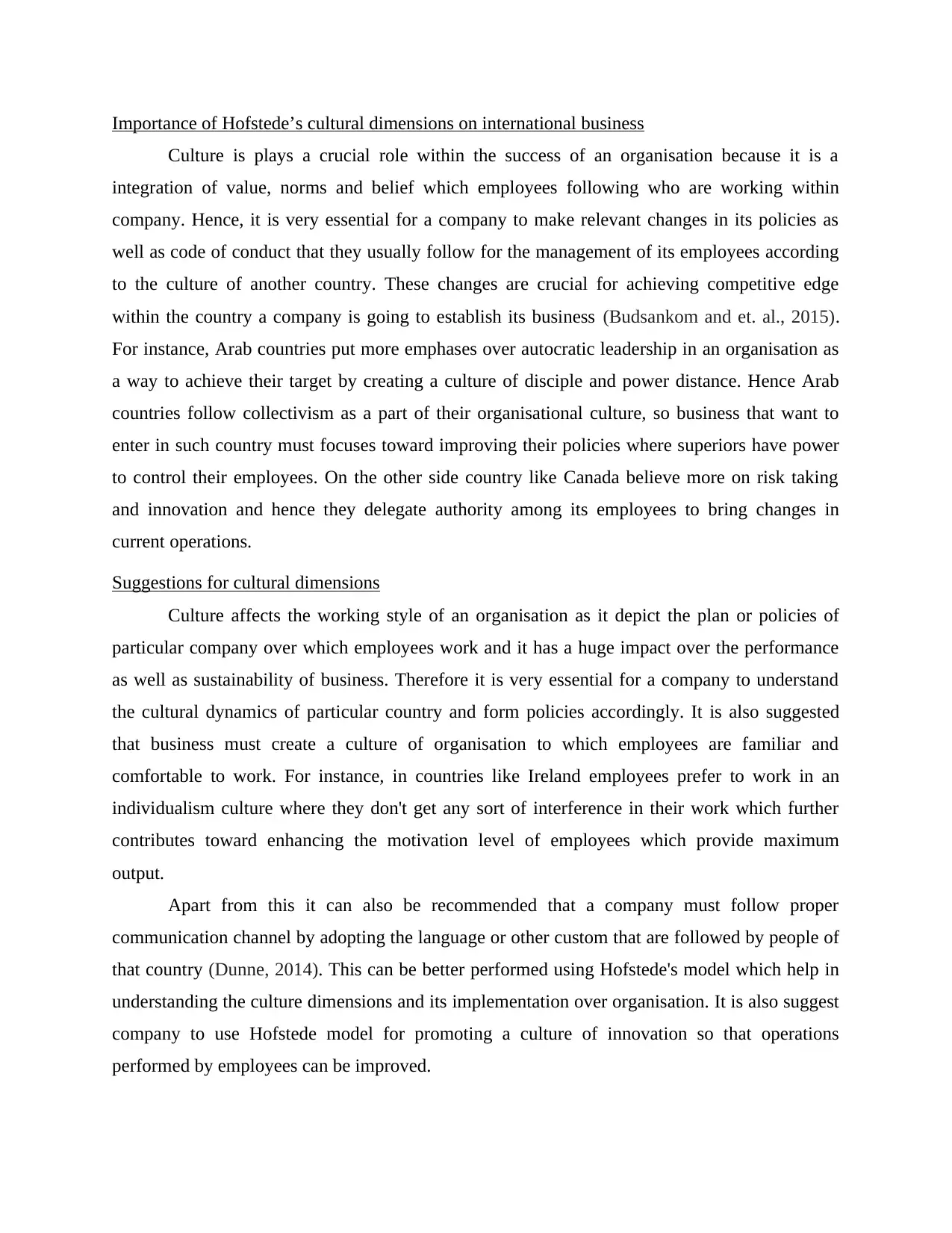
Importance of Hofstede’s cultural dimensions on international business
Culture is plays a crucial role within the success of an organisation because it is a
integration of value, norms and belief which employees following who are working within
company. Hence, it is very essential for a company to make relevant changes in its policies as
well as code of conduct that they usually follow for the management of its employees according
to the culture of another country. These changes are crucial for achieving competitive edge
within the country a company is going to establish its business (Budsankom and et. al., 2015).
For instance, Arab countries put more emphases over autocratic leadership in an organisation as
a way to achieve their target by creating a culture of disciple and power distance. Hence Arab
countries follow collectivism as a part of their organisational culture, so business that want to
enter in such country must focuses toward improving their policies where superiors have power
to control their employees. On the other side country like Canada believe more on risk taking
and innovation and hence they delegate authority among its employees to bring changes in
current operations.
Suggestions for cultural dimensions
Culture affects the working style of an organisation as it depict the plan or policies of
particular company over which employees work and it has a huge impact over the performance
as well as sustainability of business. Therefore it is very essential for a company to understand
the cultural dynamics of particular country and form policies accordingly. It is also suggested
that business must create a culture of organisation to which employees are familiar and
comfortable to work. For instance, in countries like Ireland employees prefer to work in an
individualism culture where they don't get any sort of interference in their work which further
contributes toward enhancing the motivation level of employees which provide maximum
output.
Apart from this it can also be recommended that a company must follow proper
communication channel by adopting the language or other custom that are followed by people of
that country (Dunne, 2014). This can be better performed using Hofstede's model which help in
understanding the culture dimensions and its implementation over organisation. It is also suggest
company to use Hofstede model for promoting a culture of innovation so that operations
performed by employees can be improved.
Culture is plays a crucial role within the success of an organisation because it is a
integration of value, norms and belief which employees following who are working within
company. Hence, it is very essential for a company to make relevant changes in its policies as
well as code of conduct that they usually follow for the management of its employees according
to the culture of another country. These changes are crucial for achieving competitive edge
within the country a company is going to establish its business (Budsankom and et. al., 2015).
For instance, Arab countries put more emphases over autocratic leadership in an organisation as
a way to achieve their target by creating a culture of disciple and power distance. Hence Arab
countries follow collectivism as a part of their organisational culture, so business that want to
enter in such country must focuses toward improving their policies where superiors have power
to control their employees. On the other side country like Canada believe more on risk taking
and innovation and hence they delegate authority among its employees to bring changes in
current operations.
Suggestions for cultural dimensions
Culture affects the working style of an organisation as it depict the plan or policies of
particular company over which employees work and it has a huge impact over the performance
as well as sustainability of business. Therefore it is very essential for a company to understand
the cultural dynamics of particular country and form policies accordingly. It is also suggested
that business must create a culture of organisation to which employees are familiar and
comfortable to work. For instance, in countries like Ireland employees prefer to work in an
individualism culture where they don't get any sort of interference in their work which further
contributes toward enhancing the motivation level of employees which provide maximum
output.
Apart from this it can also be recommended that a company must follow proper
communication channel by adopting the language or other custom that are followed by people of
that country (Dunne, 2014). This can be better performed using Hofstede's model which help in
understanding the culture dimensions and its implementation over organisation. It is also suggest
company to use Hofstede model for promoting a culture of innovation so that operations
performed by employees can be improved.
Paraphrase This Document
Need a fresh take? Get an instant paraphrase of this document with our AI Paraphraser
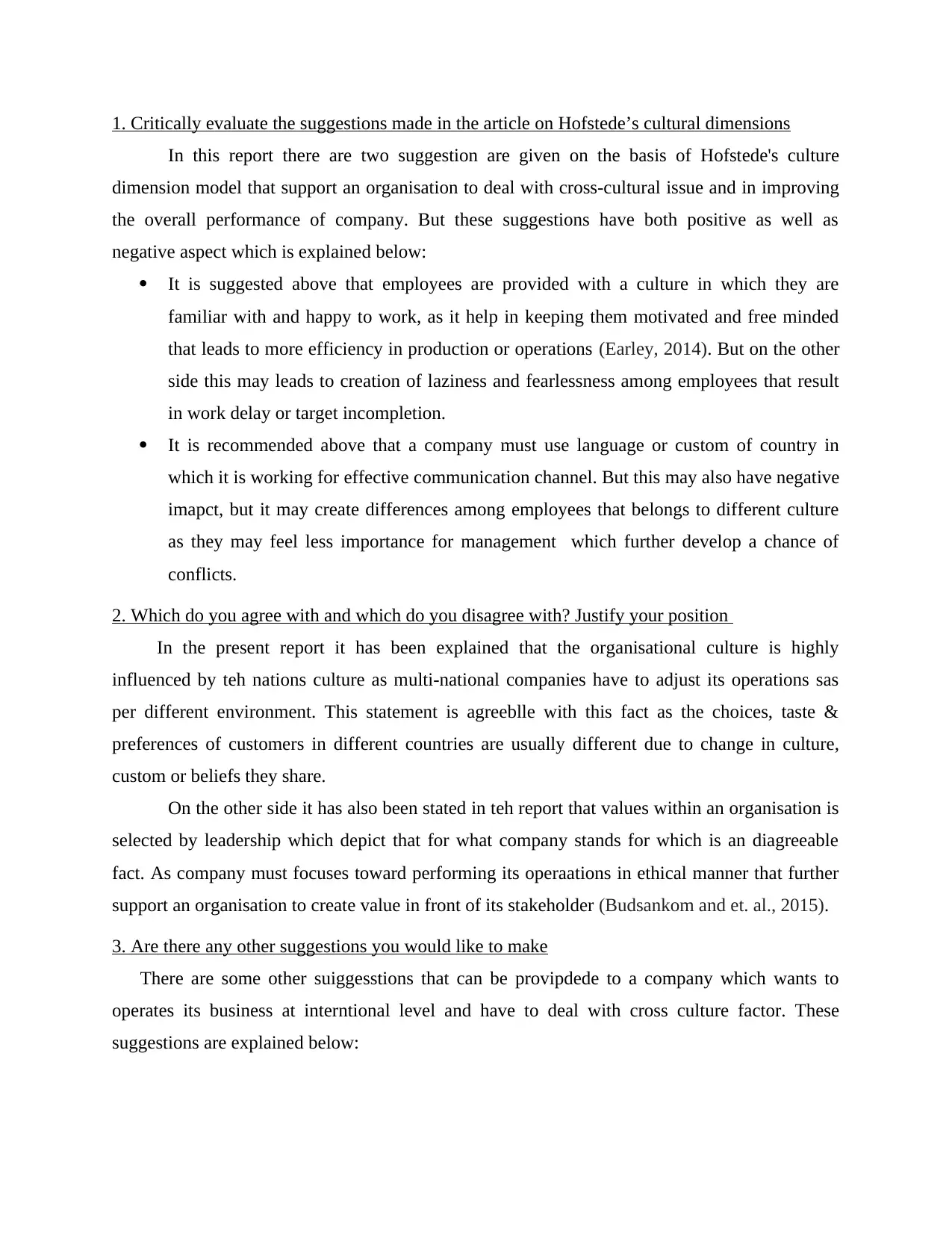
1. Critically evaluate the suggestions made in the article on Hofstede’s cultural dimensions
In this report there are two suggestion are given on the basis of Hofstede's culture
dimension model that support an organisation to deal with cross-cultural issue and in improving
the overall performance of company. But these suggestions have both positive as well as
negative aspect which is explained below:
It is suggested above that employees are provided with a culture in which they are
familiar with and happy to work, as it help in keeping them motivated and free minded
that leads to more efficiency in production or operations (Earley, 2014). But on the other
side this may leads to creation of laziness and fearlessness among employees that result
in work delay or target incompletion.
It is recommended above that a company must use language or custom of country in
which it is working for effective communication channel. But this may also have negative
imapct, but it may create differences among employees that belongs to different culture
as they may feel less importance for management which further develop a chance of
conflicts.
2. Which do you agree with and which do you disagree with? Justify your position
In the present report it has been explained that the organisational culture is highly
influenced by teh nations culture as multi-national companies have to adjust its operations sas
per different environment. This statement is agreeblle with this fact as the choices, taste &
preferences of customers in different countries are usually different due to change in culture,
custom or beliefs they share.
On the other side it has also been stated in teh report that values within an organisation is
selected by leadership which depict that for what company stands for which is an diagreeable
fact. As company must focuses toward performing its operaations in ethical manner that further
support an organisation to create value in front of its stakeholder (Budsankom and et. al., 2015).
3. Are there any other suggestions you would like to make
There are some other suiggesstions that can be provipdede to a company which wants to
operates its business at interntional level and have to deal with cross culture factor. These
suggestions are explained below:
In this report there are two suggestion are given on the basis of Hofstede's culture
dimension model that support an organisation to deal with cross-cultural issue and in improving
the overall performance of company. But these suggestions have both positive as well as
negative aspect which is explained below:
It is suggested above that employees are provided with a culture in which they are
familiar with and happy to work, as it help in keeping them motivated and free minded
that leads to more efficiency in production or operations (Earley, 2014). But on the other
side this may leads to creation of laziness and fearlessness among employees that result
in work delay or target incompletion.
It is recommended above that a company must use language or custom of country in
which it is working for effective communication channel. But this may also have negative
imapct, but it may create differences among employees that belongs to different culture
as they may feel less importance for management which further develop a chance of
conflicts.
2. Which do you agree with and which do you disagree with? Justify your position
In the present report it has been explained that the organisational culture is highly
influenced by teh nations culture as multi-national companies have to adjust its operations sas
per different environment. This statement is agreeblle with this fact as the choices, taste &
preferences of customers in different countries are usually different due to change in culture,
custom or beliefs they share.
On the other side it has also been stated in teh report that values within an organisation is
selected by leadership which depict that for what company stands for which is an diagreeable
fact. As company must focuses toward performing its operaations in ethical manner that further
support an organisation to create value in front of its stakeholder (Budsankom and et. al., 2015).
3. Are there any other suggestions you would like to make
There are some other suiggesstions that can be provipdede to a company which wants to
operates its business at interntional level and have to deal with cross culture factor. These
suggestions are explained below:
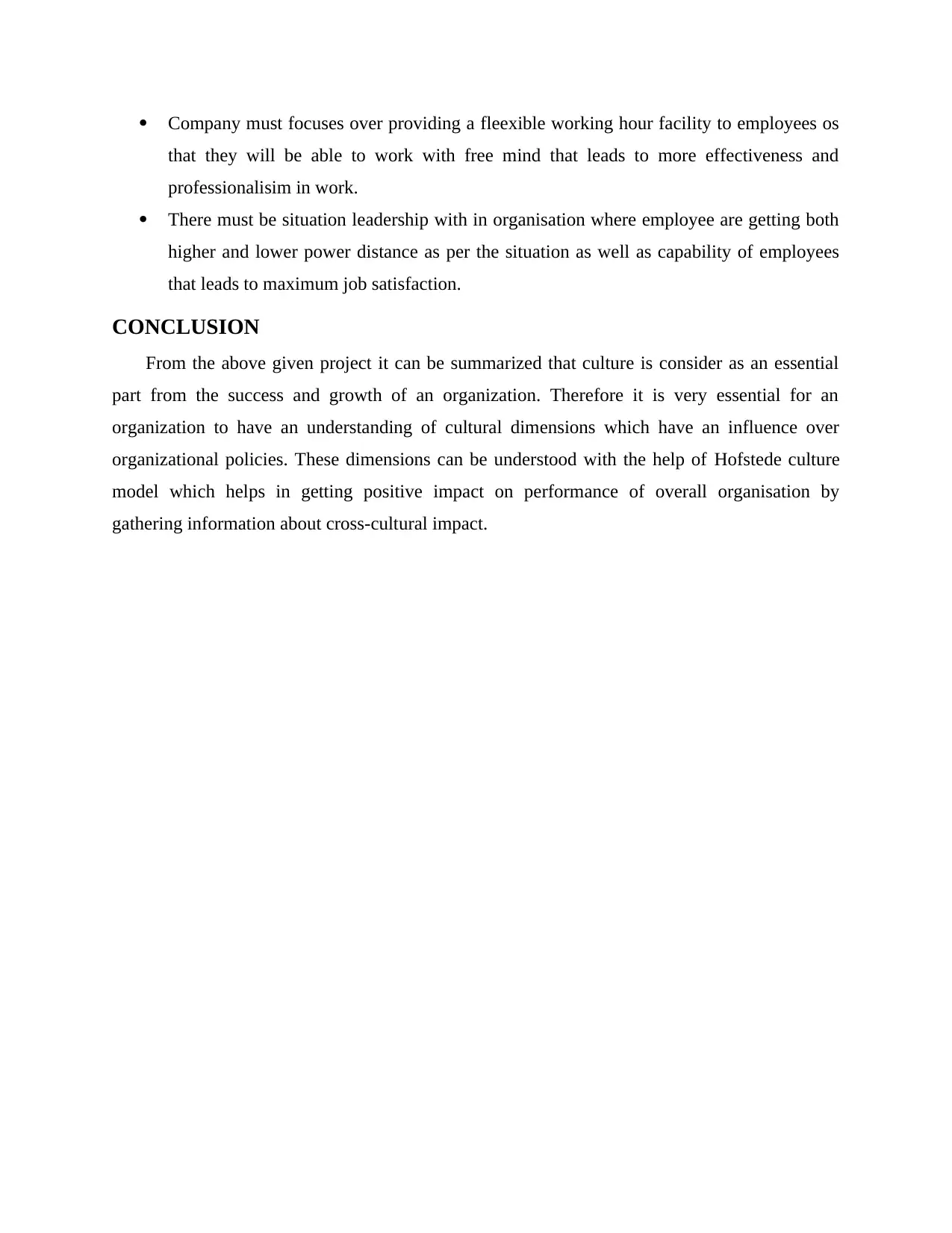
Company must focuses over providing a fleexible working hour facility to employees os
that they will be able to work with free mind that leads to more effectiveness and
professionalisim in work.
There must be situation leadership with in organisation where employee are getting both
higher and lower power distance as per the situation as well as capability of employees
that leads to maximum job satisfaction.
CONCLUSION
From the above given project it can be summarized that culture is consider as an essential
part from the success and growth of an organization. Therefore it is very essential for an
organization to have an understanding of cultural dimensions which have an influence over
organizational policies. These dimensions can be understood with the help of Hofstede culture
model which helps in getting positive impact on performance of overall organisation by
gathering information about cross-cultural impact.
that they will be able to work with free mind that leads to more effectiveness and
professionalisim in work.
There must be situation leadership with in organisation where employee are getting both
higher and lower power distance as per the situation as well as capability of employees
that leads to maximum job satisfaction.
CONCLUSION
From the above given project it can be summarized that culture is consider as an essential
part from the success and growth of an organization. Therefore it is very essential for an
organization to have an understanding of cultural dimensions which have an influence over
organizational policies. These dimensions can be understood with the help of Hofstede culture
model which helps in getting positive impact on performance of overall organisation by
gathering information about cross-cultural impact.
⊘ This is a preview!⊘
Do you want full access?
Subscribe today to unlock all pages.

Trusted by 1+ million students worldwide
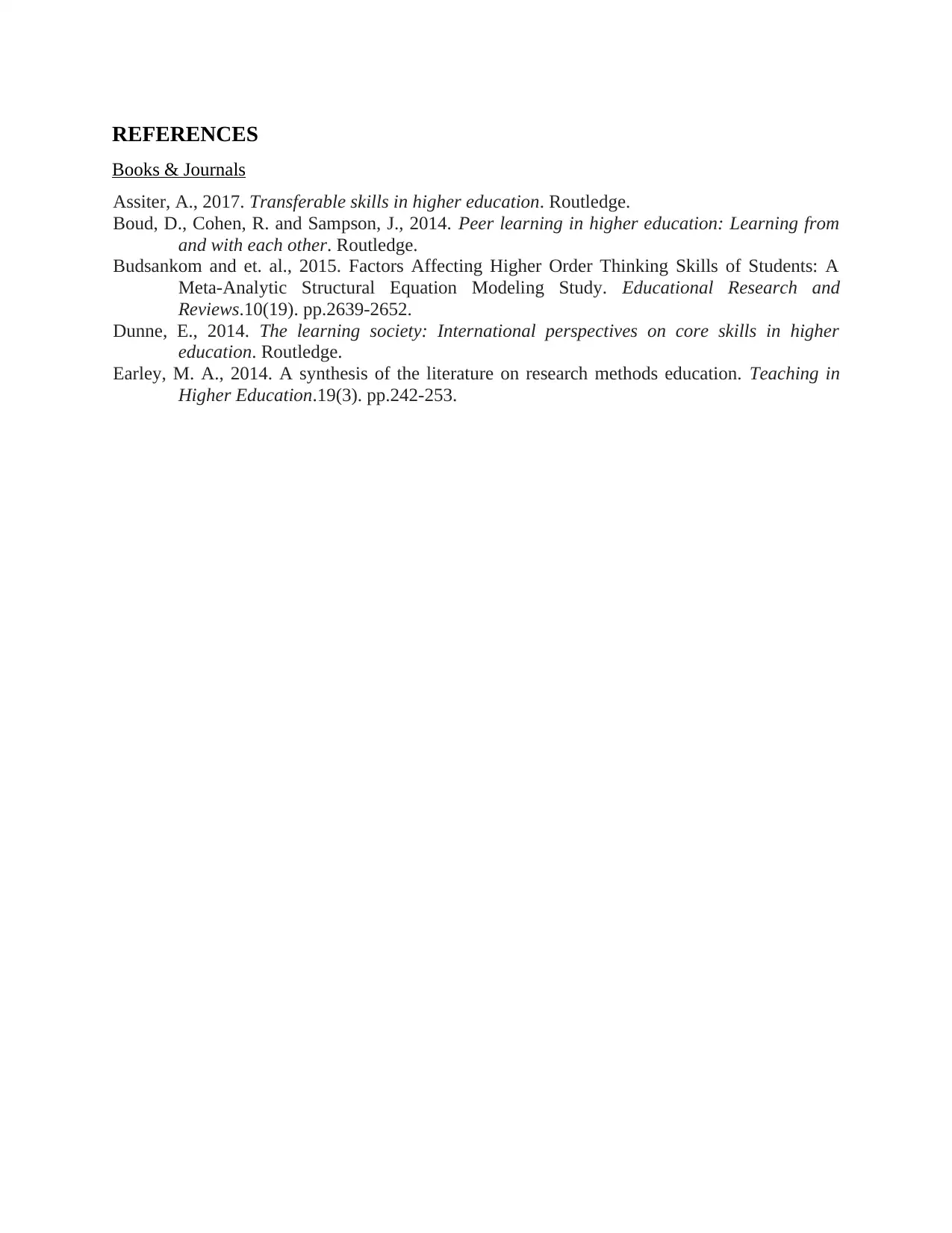
REFERENCES
Books & Journals
Assiter, A., 2017. Transferable skills in higher education. Routledge.
Boud, D., Cohen, R. and Sampson, J., 2014. Peer learning in higher education: Learning from
and with each other. Routledge.
Budsankom and et. al., 2015. Factors Affecting Higher Order Thinking Skills of Students: A
Meta-Analytic Structural Equation Modeling Study. Educational Research and
Reviews.10(19). pp.2639-2652.
Dunne, E., 2014. The learning society: International perspectives on core skills in higher
education. Routledge.
Earley, M. A., 2014. A synthesis of the literature on research methods education. Teaching in
Higher Education.19(3). pp.242-253.
Books & Journals
Assiter, A., 2017. Transferable skills in higher education. Routledge.
Boud, D., Cohen, R. and Sampson, J., 2014. Peer learning in higher education: Learning from
and with each other. Routledge.
Budsankom and et. al., 2015. Factors Affecting Higher Order Thinking Skills of Students: A
Meta-Analytic Structural Equation Modeling Study. Educational Research and
Reviews.10(19). pp.2639-2652.
Dunne, E., 2014. The learning society: International perspectives on core skills in higher
education. Routledge.
Earley, M. A., 2014. A synthesis of the literature on research methods education. Teaching in
Higher Education.19(3). pp.242-253.
1 out of 7
Related Documents
Your All-in-One AI-Powered Toolkit for Academic Success.
+13062052269
info@desklib.com
Available 24*7 on WhatsApp / Email
![[object Object]](/_next/static/media/star-bottom.7253800d.svg)
Unlock your academic potential
Copyright © 2020–2025 A2Z Services. All Rights Reserved. Developed and managed by ZUCOL.




